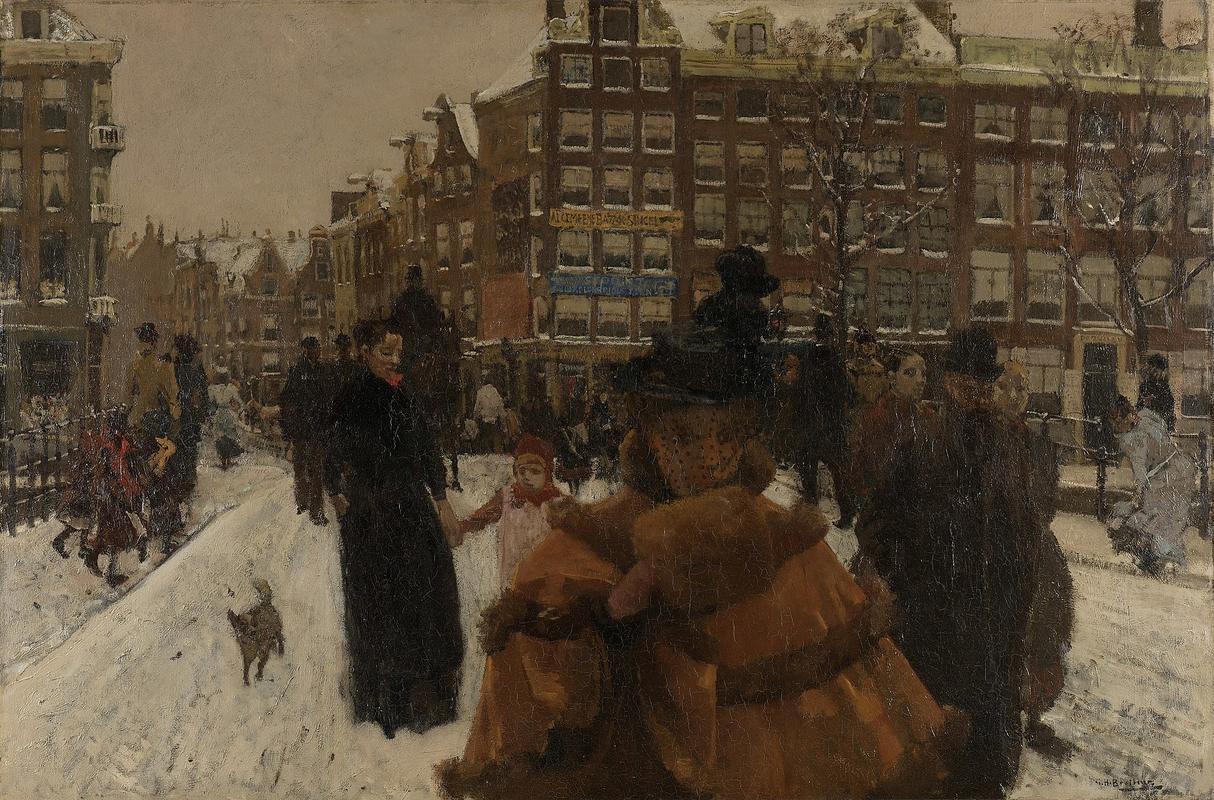More about The Singel Bridge at the Paleisstraat in Amsterdam

Contributor
Like the antagonism between Cardi B and Nicki Minaj in 2018, Breitner would compose The Singel Bridge at the Paleisstraat in Amsterdam in opposition to the work of another, competing artist, Vincent van Gogh.
Looking at the work of each artist in comparison, "it is hard to imagine a greater contrast" than between the two men, who once explored rough streets together and lent each other novels for ideas. Where van Gogh is warm, dramatic, and proto-psychedelic, Breitner is foggy, unfinished, and unfocused. Where van Gogh despised the city and yearned for rural scenery, Breitner made the city the main object of his artwork. A collection of photographs taken by Breitner, rediscovered and made public only in 1961, shows that he was a skilled photographer who put a special emphasis in his photos on the everyday, apparently insignificant, scenes of the unpredictable turn-of-the-century city.
Around ten years after meeting van Gogh, Breitner harshly criticized him in a strange review of one of his exhibitions: "I think van Gogh is making art for Eskimos. I cannot enjoy it. I find it crude and insipid, without the slightest distinction, and, on top of that, everything is stolen from Millet and others." We can assume that Breitner's "art for Eskimos" comment is like the saying "it's all Greek to me," disappointingly using the culturally distant, but geographically close, Inuit and Iñupiat as the butt of a joke that relies on the idea that nobody likes or understands van Gogh. The Millet observation is a criticism of van Gogh's subject matter and tone, which are similar to that of Millet and his Barbizon school. But this catty letter throws light on the real function of Breitner's approach in The Singel Bridge at the Paleisstraat in Amsterdam: to sabotage the whole system of bucolic, creatively rendered countryside scenes, nostalgically referencing a time before train tracks and industrial labor put everyone's life into fast-forward. Instead, Breitner throws himself headfirst into the corruption and imprecision of the city, using high constrast, off-balance figures and unglamorous subjects to tell a story of the necessity of putting the good ol' days, if they were ever actually that good, behind us.
Despite his dismissal of van Gogh, today Breitner is the artist whose work looks more strange. One of the major goals of his entire life's work, especially as displayed in The Singel Bridge at the Paleisstraat in Amsterdam, is to tell us about the type of woman he likes. Like T-Pain and Juvenile, Breitner is unequivocally interested in a woman who has to struggle to make a living because she, unlike her bourgeois sisters, represents a "race, in the artistic sense." "The so-called bourgeoisie don't provide any substance for my art," Breitner adds. "Bourgeois character is faint and lacking in spirit...so there is no other choice for me than everyday women."
Sources
- van Duijvelshoff, Daphne Peski, et al. A Survey of the Collection. Amsterdam: Stedelijk Museum, 1989.
- van Garrel, B. "Het getekende bestaan van G.H. Breitner." Haagse Post, Jun. 23, 1973, jrg. 60, nr. 25.
- Nguyen, Hao. "'Slow Motion' was Juvenile's First #1 Hit." Stop the Breaks, 2014, https://www.stopthebreaks.com/gems/slow-motion-juvenile-first-number-1-….
- Wieringa, Jacobine. "Breitner en Parijs. De invloed van het verblijf in Parijs op het leven en werk van George Breitner." Utrecht University, 2005, https://dspace.library.uu.nl/handle/1874/8382.
Featured Content
Here is what Wikipedia says about The Singel Bridge at the Paleisstraat in Amsterdam
The Singel Bridge at the Paleisstraat in Amsterdam (Dutch: De Singelbrug bij de Paleisstraat in Amsterdam) is an oil painting made by George Hendrik Breitner in 1896 or 1898. The painting shows people walking on the Singel Bridge at the Paleisstraat in Amsterdam. The work is oil on canvas of 100 cm (39 in) by 152 cm (60 in). The painting is in the collection of the Rijksmuseum in Amsterdam.

Check out the full Wikipedia article about The Singel Bridge at the Paleisstraat in Amsterdam












